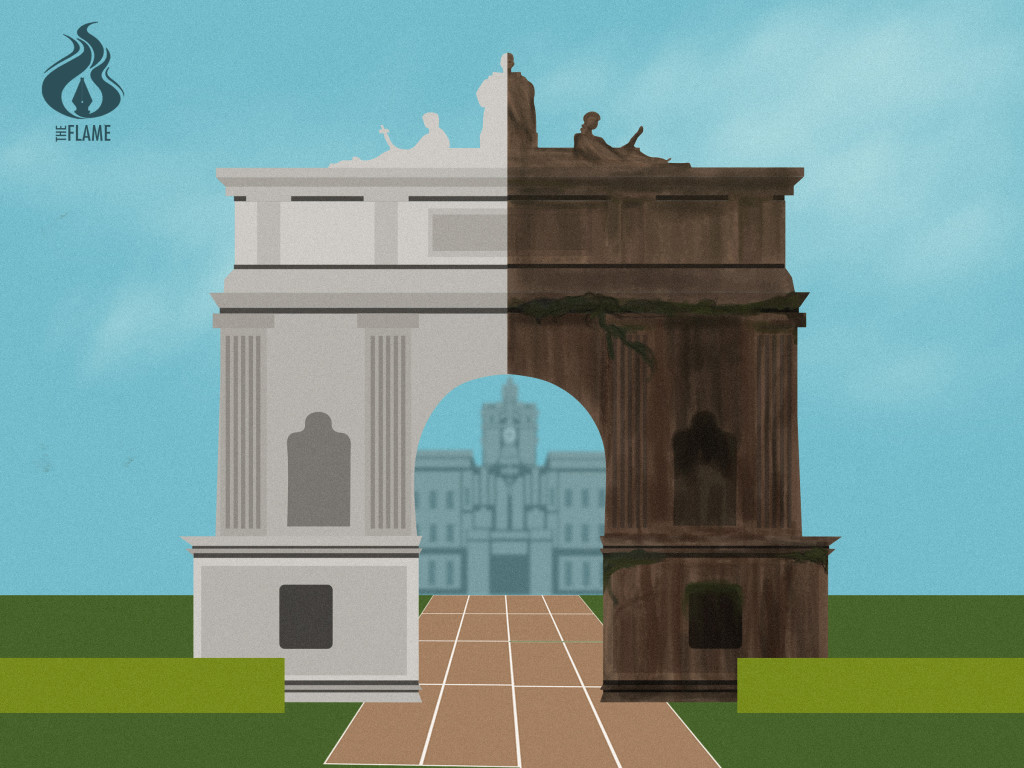
WITH OVER four centuries of its presence in the educational and religious landscape of the country, the University of Santo Tomas (UST) has been a witness to several significant moments in history as it withstood the test of time.
The University, which is home to national cultural treasures like the Arch of the Centuries and the Main Building, has also faced the wear and tear of these important landmarks over the years.
In pursuit to take care of the remnants of its glorious past, the preservation of these national treasures proves to be a challenge for the Thomasian community’s pool of heritage conservationists.
Recently, the Arch of the Centuries and the Main Building were seen to be undergoing physical refinements. With renovations being done to maintain their structural integrity and the safety of their occupants, the antiquated landmarks were observed to be lighter and cleaner than usual.
This observation sparked the attention of some members of the Thomasian community.
One Facebook user named Jose Marie Tan posted a photo of the Arch of the Centuries last July 1 after noticing the change on its appearance.
In the said post, which has gained 238 likes and 1, 514 shares as of press time, Tan wrote, “Hello Arch of the Centuries, anong nangyari sa’yo? Sabi ni manong, nabakbak ‘yung semento dahil sa ginamit nilang high pressure cleaner, [sesementuhin] na lang daw nila ulit.”
Other netizens also shared their concern over the cleaning procedure done, particularly with the high-pressure cleaner that reportedly caused some parts of the Arch to “chip off.”
Many of them also asked if heritage authorities were consulted prior to the executions of such procedures to the University’s most famous landmarks.
With these concerns and speculations surrounding the conservation procedures done to the Arch of the Centuries and the Main Building, the Flame sought the opinion of heritage preservation experts.
Architect Rino Fernandez of the UST College of Architecture noted that the Arch of the Centuries facing España Boulevard was constructed using concrete materials only, and the part facing the Main Building contains the original stones made of adobe from the University’s former Intramuros campus.
In his opinion, the stones that incorporate the structure are crucial in determining the cleaning materials and procedure to be used. “The softer the materials, dapat walang pressure. Pero ‘pag harder (‘yung material)… pwede kang mag-apply ng pressure,” he said.
High-pressure cleaning, according to asset integrity research site corrosionpedia.com, “is the use of high-pressure water to remove grime, loose paint, mud, mold, dust, and other types of stubborn dirt on the surfaces of tanks, buildings, vehicles, streets, bridges, pipes,” and many more structures.
Since adobe is a soft material, Fernandez said that it cannot be cleaned with pressurized water and instead, herbicide can be used to lessen the vegetation or the accumulation of moss on the Arch’s surface. However, he said that pressurized cleaning could be applied on the part of the Arch facing España as it is made of concrete.
Assoc. Prof. Eric Zerrudo, on the other hand, said that the high-pressure cleaning will only “take off the loose parts” of the surface.
The Director of the UST Graduate School’s Center for Conservation of Cultural Property and Environment in the Tropics said that given the Arch’s function in University activities and its “weather-beaten condition,” the high-pressure cleaning could be one practical way of removing the dirt.
He explained that applying reversible plasters is just a palliative measure after cleaning the stones. “Kasi iniisip ko rin ‘pag di mo siya pinressure, may [matitirang dumi] ‘dyan. Kung may matitira dyan [at] magpa-palliative ka, baka mamaya lalo mo lang binaon ‘yung dumi,” Zerrudo said.
He added that just like the dental procedure of filling, the plasters temporarily prevent cracks that cause further decay and breaking, which could eventually endanger the whole structure.
Meanwhile, Architect Benjamin Empleo, a historical researcher of the National Historical Commission of the Philippines (NHCP) said that cleaning structures made of adobe is a “very tedious job” that involves a “scientific strategy.”
On a similar note, Zerrudo said that a full-scale conservation entails a series of documentation, experimentation, analysis and formulation, all of which he estimated could take a year. This, he said, might affect the traditional activities for the opening of the new academic year.
Contrary to the concern of the Thomasians and those online, the experts clarified that cleaning is just one of the many factors that affect the structure’s state.
Factors like extreme weather conditions, chemical reactions, longevity, and pollution in the area could have largely contributed to the eventual dilapidation or change of appearance of centuries-old structures like the Arch and the Main Building.
Moreover, even before Thomasians took notice of the visible change in the Arch and the Main Building’s appearance, Fernandez and Zerrudo have observed that the Arch’s surface has been decaying and flaking.
As such, they both suggested to replace the chipping surface using the same authentic materials to sustain the structure, as conservation measures take several years to complete.
Although the evident concern of the Thomasians could be a good sign of their symbolic attachment to the University’s national treasures, Zerrudo said that this vigilance serves as a challenge to the University’s heritage workers.
“This is a challenge to many of our heritage workers here– How do we communicate it (conservation) properly to the [Thomasian] community and what are the options and the approaches that we can take on (to take care of these prized treasures)?” F ALTON L. ESPERA and ALYSSA JOY E. PAYUMO



